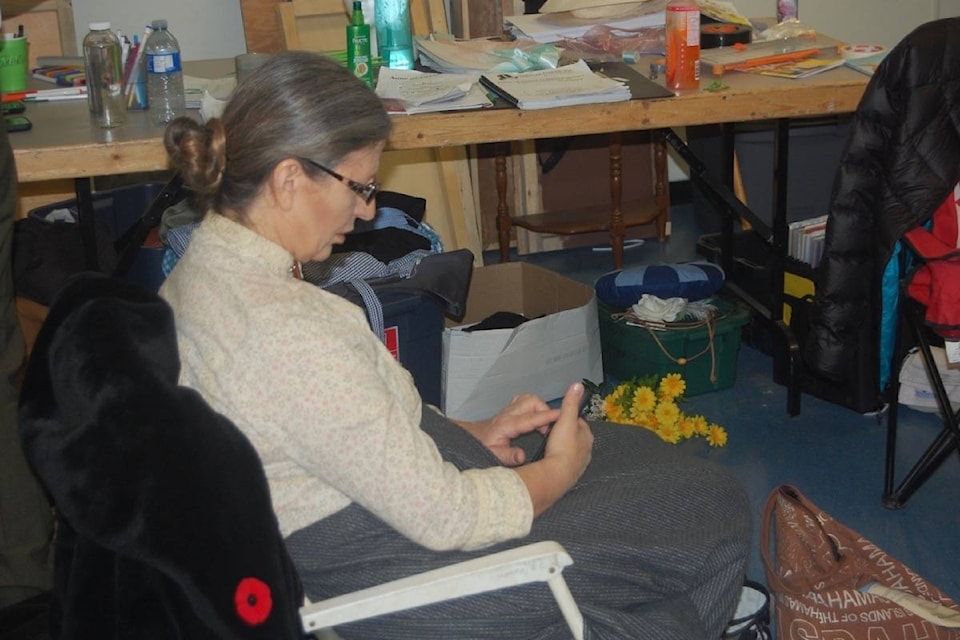In the past, I’ve always ended my “Theatre Diaries” series with the run-up to opening night. A few people have asked what it’s like when the performances actually start; so here’s a behind-the-scenes look at what happens when stuff gets real.
For all performances of Anne of Green Gables: The Musical, cast and crew are asked to be at the HUB two hours before the start of the show (some people are there much earlier); those who don’t need help with make-up and/or hair can be there a bit later. The green room—formerly the rehearsal room—is a hive of activity, as cast members arrive and get into costume, then seek assistance with make-up (mostly the men and children) and hair (children and some of the women) as needed. Cassidy Clayton, Seanna Sampson, Donna Middleton, and Alyssa Hand—as well as some cast members—are on hand to help.
Also on hand is seamstress extraordinaire Margaret Moreira, ready with needle, thread, and scissors before and during each performance to help with any wardrobe mishaps (“Not as many as with My Fair Lady,” she quips). Still, mishaps do occur, and Margaret is there to fix them.
There is a vocal warm-up on the stage an hour before the performance, after which the actors retreat to the green room. All available chairs at the HUB—including those that were formerly in the green room during rehearsals—have been commandeered for the audience, so quite a few cast members have brought folding chairs. With the vocal warm-up done, and most cast members in full hair, costume, and make-up, there is a feeling of “Hurry up and wait” as we count down the minutes to performance time.
Cast members in 1907-era costumes sit around the green room, almost all of them preoccupied with their smartphones. It’s a somewhat startling sight, watching people dressed in early 20th century costumes engrossed in 21st century technology. Since many people involved in the production won’t have had much chance to eat, a table at the back of the green room contains fruit, veggies, dips, crackers, chips, cold cuts, salsa, homemade soup, and more.
The mood before performances—even on opening night—is light. Actors crack jokes, share news, munch away at the snack table, and bustle in and out of the green room. It’s not unusual for someone to break into song and have everyone else join in, regardless of whether it’s a song they’re in or not: by this point we all know every song, and almost every line of dialogue, as if they were our own. When we are gathered together for a group photo, instead of “Cheese!” we break into a spontaneous chant of one of the show’s lines: “Anne Shirley has a very bad temper!”
After one of the younger actors goes AWOL before a key scene during one of the dress rehearsals, Tia Hook is appointed “kid wrangler”. Her task (one she carries out flawlessly through six performances) is to ensure that all the young actors are in place and ready before their scenes. On opening night they are all on the permanent stage in the HUB with most of the rest of the cast, hidden from view by a curtain and ready to sing the prologue.
The only cast members not on that stage are the four ladies who are in the opening number, “Great Workers for the Cause”. We are backstage right, and once Nancy White has finished welcoming the audience we all launch into the prologue. As the final word—“young”—fades away I take a deep breath, wait for the music cue, and step onto the stage—blinking a little at the sudden transition from dark to light—singing “Every Tuesday afternoon / We take up our positions / In the Rummage Brigade to the Ladies’ Aid / To the Board of Foreign Missions.”
After I exit I stay backstage to watch as Matthew meets Anne for the first time, and then to hear the lovely song “We Clearly Requested a Boy”. I am stage right, where stage manager Jessica Clement has taped detailed layouts of every scene to the back of the set, showing what needs to be where on stage and when. From the audience’s viewpoint, I am sure the scene changes look seamless; but anyone standing backstage knows the controlled chaos taking place, as items are pulled, carried, and wheeled offstage and other items take their place.
By the time of the final performance—a matinee on Sunday, November 5—the strain is beginning to show (backstage; not onstage). Between full rehearsals and performances, this is our ninth performance in eight days. It’s what a professional theatre company would do on Broadway; but we’re not a professional theatre company, and a nasty bug has been laying several cast members low (the author lost her voice after the Sunday matinee).
As we go through the final performance, I experience (after five previous WRAPS theatre productions as an actor) a familiar feeling of melancholy. As I stand backstage listening to “We Clearly Requested a Boy”, I think “This is the last time I’ll ever hear Vivian and Jim and Theresa sing this.” I relish my last chance to try to take the credit for Anne’s success in “If It Hadn’t Been for Me”. And as we stand, hidden backstage, waiting to sing the coda, the entire cast spontaneously links hands.
The after-party is held, by tradition, at John Kidder’s house, and more than two-dozen cast and crew members cram into John’s kitchen and living-room to relax and go over our most recent success. As is also tradition, we start thinking about what’s next, and various suggestions are tossed into the ring. What will be the subject of the next “Theatre Diaries” series? Watch this space… .
editorial@accjournal.ca
Like us on Facebook and follow us on Twitter
